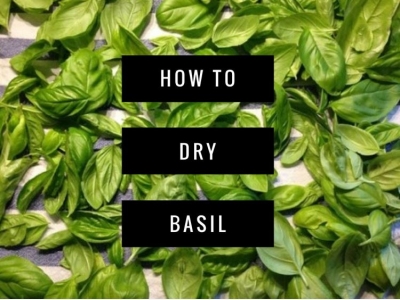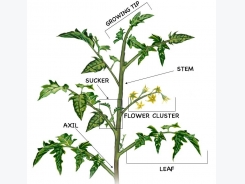How to Dry Basil

Most people are familiar with basil in its dried, crushed form. Some are familiar with it in its fresh form as well. So how do you get it from fresh to dried?
It's not hard at all and requires no special tools or equipment. There are two options for drying basil: air drying and oven drying. Some people use a microwave, but there are a lot of reasons not to do this.
Microwave NO, Toaster Oven YES!
Using a microwave to dry any herb, especially herbs like basil whose primary flavor is in its oil, is a bad idea. Microwaves work by agitating the water molecules in whatever is inside the oven. This agitation has side effects. In the case of basil, it breaks down the oils. Toaster ovens, on the other hand, use conventional heat to do the job, so they are like smaller versions of standard ovens.
Picking Basil
The first step in drying basil is to pick it from the garden. You want it to be ripe and ready, but basically any basil leaf that is fully formed is a good herb. Most growers wait until the leaves are two or three inches in length before cutting. Those who grow a kitchen garden and are harvesting before winter sets in, however, may have shorter plants because they've been trimming all year to use the herbs in their recipes.
Regardless, for the final cut, cut the leaves as far down the stem as you can reach. If you use a sharp pair of scissors or a knife, you can cut near the soil and get bundles in handful sizes. This makes it easier to not only harvest, but deal with the basil leaves up to the time you begin the drying process.
You should pick basil on the same day you plan to begin the drying process. Unless extreme weather or another hazard to the plants is on its way, it's best to cut the basil when you're ready to use it. Once you have the leaves cut, wash them thoroughly under water roughly the same temperature as the location where the basil was growing (likely outdoors at ambient temp). This keeps them from being shocked, which can cause premature curling.
Dry Basil in the Oven
The bundles can be separated into individual leaves. To use the oven (or toaster oven), you'll need to remove the stems as well. These will burn in the oven and ruin the taste of the basil leaves. So you'll have a lot of cleanup to do. Use sharp scissors and cut the base of the leaf to remove the stem entirely. Trim any burnt areas of the leaf (edges, tips) from sun exposure as well.
Once this is done, lay the basil on oven-safe sheets such as baking sheets (ceramic if you have it), big plates, etc. Set the oven to around 250-300 degrees (lower is better, but takes longer). You don't want to "cook" the basil, just dry it out. If you live in a humid area, keep the oven door propped open slightly to allow the air to circulate a little and let evaporated moisture out of the oven.
A tray of single-layer leaves will take several hours (at least 6) to dry. Turn the oven off, but leave the leaves in there when they are curling from dehydration. In an hour or so, remove them from the oven and check one. It should be brittle and crush easily in your fingers. If not, put them back in for another hour. Watch them carefully to be sure they don't burn!
Air Drying Basil
This is an easier, natural method, but it takes a lot of time (to dry, not on your part). Rather than separating the bundles, tie a string to the base of the stems and wrap the bundle in paper towels or newspaper. Hang them upside down in a warm, dry area that doesn't get direct sunlight. Many cooks love the smell and keep basil drying in their kitchens by hanging it above fixtures, in cabinets, etc.
Alternatively, you can put cut leaves (with or without stems, but loose) in a bowl and stir every couple of days to keep them rotating so they don't compost. This takes a week or so longer than hanging.
Air dried basil is said to taste better and takes about 4-6 weeks to complete, depending on method and your climate.
Có thể bạn quan tâm
Phần mềm

Phối trộn thức ăn chăn nuôi

Pha dung dịch thủy canh

Định mức cho tôm ăn

Phối trộn phân bón NPK

Xác định tỷ lệ tôm sống

Chuyển đổi đơn vị phân bón

Xác định công suất sục khí

Chuyển đổi đơn vị tôm

Tính diện tích nhà kính

Tính thể tích ao hồ



 How to Grow Kalettes: New Superfood, the Kale…
How to Grow Kalettes: New Superfood, the Kale…  How To Prune Tomatoes For A Big Harvest
How To Prune Tomatoes For A Big Harvest